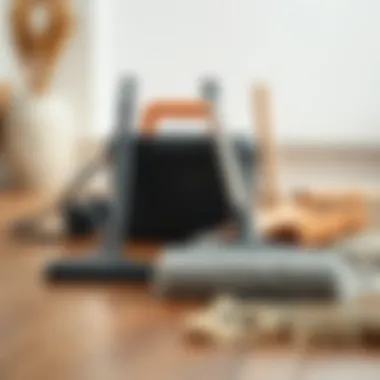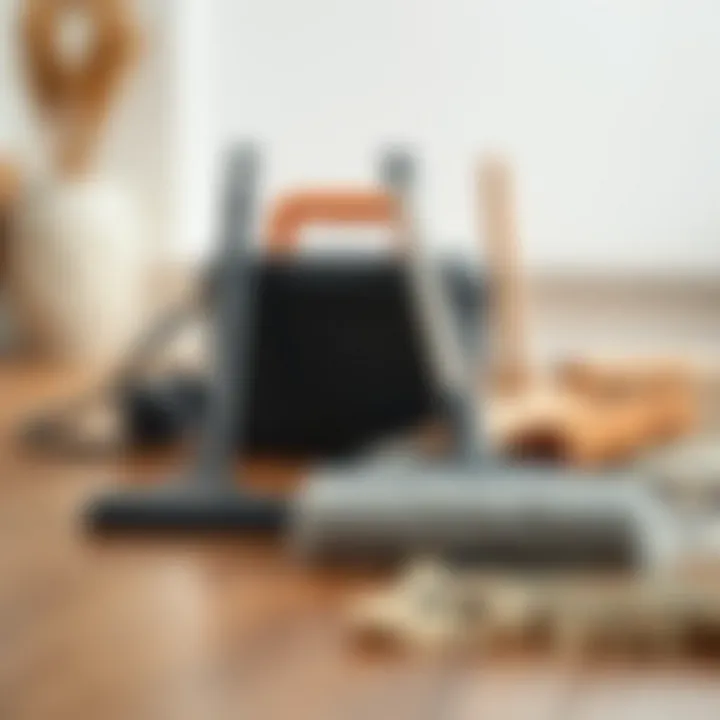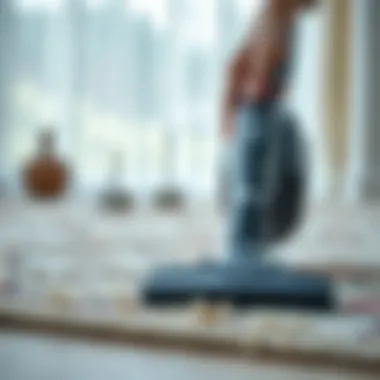Effective Methods for Cleaning Area Rugs


Intro
Cleaning area rugs is not just about removing dirt and stains; it’s about preserving the beauty and extending the life of a cherished element in your home. This guide offers a roadmap for homeowners looking to enhance their living spaces, providing practical techniques for various rug types. Homeowners may think of rugs as mere decorative pieces, but they often play a key role in defining the atmosphere of a room—warmth, elegance, and comfort.
When it comes to rugs, one size does not fit all. Different materials require unique approaches to ensure they are cleaned effectively without compromising their integrity. From cotton and wool to synthetic fibers, each material comes with its own set of cleaning challenges and advantages. The objective here is to navigate through the myriad of cleaning methods, equipping readers with the knowledge to keep their rugs in pristine condition.
Cleaning isn’t just a seasonal chore; it’s an ongoing commitment to maintaining the look and feel of your space. As we delve into various cleaning methodologies—ranging from simple vacuuming to more specialized approaches—let’s keep in mind that a systematic approach is key. Not only will this guide articulate effective cleaning methods, but it will also suggest how to maintain these rugs over the years.
Featured Homes
In the context of rugs, understanding the homes where these pieces often reside adds another layer of richness to this discussion. There are numerous architectural styles that can enhance the visual appeal of area rugs, turning them into conversation starters. Rug enthusiasts will often find striking rugs in settings that showcase specific design elements.
Architectural Styles
Homeowners with a flair for design might appreciate how various architectural styles affect the aesthetic of area rugs.
- Modern homes often feature minimalist designs that allow vibrant rugs to pop.
- Traditional abodes may utilize ornate rugs that echo the home’s intricate moldings.
- Eclectic spaces bring together diverse patterns, making the selection of area rugs a creative endeavor.
When choosing an area rug, the home’s architectural nuances must be considered. Not all rugs will complement every space, so a discerning eye can highlight pieces that harmonize well.
Unique Design Elements
Within these homes, unique design elements further enhance the interaction between rugs and furnishings. Factors such as color schemes, textures, and layout are instrumental. For instance:
- A shaggy rug can provide contrast in a sleek, polished room, adding depth and warmth.
- On the other hand, a large, geometric rug can help unify a space, anchoring individual pieces in a larger narrative.
These design choices can inform your cleaning routine. For example, high-traffic areas may require more frequent maintenance, while delicate areas may necessitate gentler approaches.
Incredible Locations
Just as the artistic expression in homes can dictate the choice of rugs, the locations where these rugs are prominent offer interesting insights into their care and cleaning. The geographical context plays a significant role in practical rug maintenance, often tied to cultural customs regarding cleanliness.
Geographic Highlights
Certain regions, known for their contributions to rug craftsmanship, often influence not only the style but also the care involved:
- Persian rugs, steeped in tradition, require meticulous cleaning techniques due to their delicate fibers.
- Turkish rugs, celebrated for their bold colors, might be more resilient, but even these require specific care to prevent fading.
Understanding these geographic highlights allows homeowners to approach the cleaning process with a sense of respect for the artistry inherently tied to each rug.
Cultural Significance
Different cultures have unique views on cleanliness and maintenance. In many Middle Eastern cultures, rugs are revered as a symbol of hospitality and should be impeccably clean to invite guests. The regiments of care vary widely—often emphasizing the importance of deep cleaning processes versus routine upkeep. Rituals tied to rug care can also provide insights into maintaining not only the rug but the life it brings to a home.
Understanding these cultural nuances can deepen one's appreciation for the cleaning process, transforming it from a chore into a meaningful practice.
The journey through this comprehensive guide will equip you with the knowledge needed to choose the right methods for your area rugs, reflecting both your personality and the character of your home.
Understanding Area Rugs
Area rugs are not just decorative pieces; they serve to enhance the overall ambiance of a space while offering comfort underfoot. Understanding the importance of area rugs in your home or establishment can make a world of difference in both aesthetics and functionality. As we navigate through this guide, it's crucial to grasp the different categories of area rugs and the common issues they face, as this will lay the groundwork for effective cleaning methods.
Types of Area Rugs
Wool Rugs
Wool rugs are often lauded for their durability and luxurious feel. They tend to maintain their shape well and can withstand foot traffic without showing too much wear. A key characteristic of wool rugs is their ability to regulate temperature, providing natural insulation to rooms. This makes them not only a popular choice for colder climates but also offers a cozy atmosphere in any setting.
However, wool rugs require special attention when it comes to cleaning. If you misuse a harsh cleaner, you might damage the fibers, leading to pilling or fading. Understanding the balance of care is essential for maintaining their beauty and longevity.
Synthetic Rugs
Synthetic rugs, made from materials such as nylon and polyester, offer a much more budget-friendly option compared to their natural counterparts. Their standout feature is stain resistance; spills can often be wiped clean with ease. This characteristic makes synthetic rugs particularly appealing for families with children or pets.
That being said, they may lack the breathability and warmth of wool alternatives. While they are often easier to clean, the synthetic fibers can wear out more quickly, making it crucial to regularly evaluate their condition for long-term use.
Silk Rugs
Silk rugs exude elegance and sophistication, making them a sought-after choice for luxury spaces. Their unique sheen and soft texture can elevate the look of any room, giving it a refined touch. One major appeal of silk rugs is their intricate designs, often reflecting high craftsmanship.
However, silk demands a gentle hand. The fibers are delicate and can be easily damaged if mishandled. It's best to limit exposure to direct sunlight to prevent fading and take extra caution during cleaning. If you want to keep these beauties functional and visually appealing, professional cleaning is usually recommended.
Natural Fiber Rugs
Natural fiber rugs, which include those made from jute, sisal, or seagrass, bring a rustic charm to interiors. Their standout characteristic is eco-friendliness; they are biodegradable and contribute to sustainable living. The textures vary from coarse to soft, depending on the fiber, allowing for diverse aesthetic choices.
While they can add warmth and an earthy feel to a space, they are susceptible to staining and become difficult to clean once dirt sets in. Regular maintenance is key, and it’s worth considering protective measures, such as applying a stain-resistant treatment to prolong their lifespan.
Common Issues with Area Rugs
Stains and Spills
One of the most glaring issues for area rugs is stains and spills. From red wine to food accidents, these mishaps can leave lasting marks if not treated promptly. Stains not only disrupt the visual appeal but can also attract dirt, making cleaning even more challenging.
Consequently, swift action is essential. Identifying the type of stain will dictate the cleaning method, so understanding the basic cleaning principles can help mitigate potential disasters.
Dirt and Dust Accumulation


Dirt and dust often sneak in unnoticed, gradually becoming embedded in the fibers of the rug. The primary issue with dirt accumulation is that it dulls the rug's appearance and can potentially damage the fibers over time. Regular vacuuming can help combat this buildup, but neglected rugs will eventually require a deep clean to restore their former glory.
Being proactive about dirt management will improve not just the look of the rug but also air quality in your home, making it an important consideration for cleaning routines.
Pet Hair and Odors
For pet owners, hair and odors can become an unforgettable part of rug maintenance. Pets naturally shed, leaving their mark almost everywhere they roam. The challenge here lies not only in removing the hair but also in eliminating associated odors that can linger long after they've left their furry footprint.
Utilizing the right tools, such as a pet hair-specific vacuum attachment, can make a noticeable difference. Additionally, a regular cleaning routine is vital to keep both hair and smells at bay, ensuring your space remains fresh and welcoming.
"Taking the time to understand the types of rugs and their unique challenges can streamline your cleaning process, resulting in a more efficient approach to maintaining your home’s aesthetics."
Preparation for Cleaning
Cleaning area rugs might sound like a straightforward task, but without the right preparation, it can lead to less than ideal results. Preparing for cleaning is a crucial step that sets the stage for an effective and efficient cleaning process. Understanding the material of your rug and its overall condition helps avoid damaging it during cleaning. This foresight not only preserves the integrity of the rug, but also ensures that you achieve the best clean possible.
Assessing Material and Condition
Identifying Rug Fiber
Identifying the fiber of your rug is like peeking behind the curtain of a magician's trick—it gives you the insight needed to approach your cleaning correctly. Different materials respond differently to cleaning techniques and products. For instance, wool rugs, celebrated for their durability, may be cleaned with mild detergents, whereas silk rugs require a more gentle touch to avoid damage.
Recognizing the specific fiber can greatly enhance your cleaning strategy. Wool's natural stain resistance is one of its key characteristics, making it a favored choice for households with pets. However, if a wool rug has been treated with other chemicals or dyes, caution is needed as these can react poorly with certain cleaners. Not only does identifying the fiber help determine your cleaning solutions, but it also informs you about the rug's sensitivity to certain environments; for example, an outdoor rug may handle moisture differently than an indoor one.
Checking for Damage
Checking for damage before attempting any cleaning is another essential preparatory step. A rug that looks sturdy may be hiding wear and tear that could be exacerbated by cleaning. Common issues like frayed edges or faded colors can often go unnoticed until cleaning begins.
Spotting these issues ahead of time allows you to treat the rug more delicately. For example, frayed edges might need you to hold back on more aggressive cleaning techniques to avoid further damage. If the damage is significant, consulting a professional cleaner might be worth considering before risking a DIY effort. Being aware of any blemishes not only helps tailor your cleaning approach but can also save you from investing time and effort in an ineffective cleaning process.
Gathering Necessary Supplies
Having the right tools on hand game-changes your cleaning experience. A lack of proper supplies can lead to half-measures or even damage to your treasured rug.
Vacuum Cleaners
A vacuum cleaner is a primary tool that every rug owner should have. Not just any model will do, though. A vacuum specifically designed for rugs helps lift dirt and allergens without damaging the fibers. HEPA filters are particularly great for those concerned about dust and pet hair. Remember, it’s not just about suction; the brush roll features are crucial as well.
The distinctive feature of some vacuum cleaners that have adjustable settings ease the transition between various rug materials. This adaptability ensures you’re not just cleaning the surface but also reaching deeper layers where dirt can accumulate.
Cleaning Solutions
Next, we come to cleaning solutions. These can make or break your cleaning efforts. It’s tempting to go for the strongest products on the market, but that can be a double-edged sword. A cleaner that is too harsh may strip color or weaken the fibers, while milder solutions might not do the job effectively.
Opting for solutions specifically formulated for your rug type is advisable. Homemade alternatives, like a mixture of water and white vinegar, prove to be safe and effective for many situations. Each cleaner has its own advantages and drawbacks—learning what works best for your rug’s fiber is essential.
Brushes and Cloths
Lastly, brushes and cloths should not be overlooked. A simple, soft-bristled brush is often all you need to maintain the fluff and richness of your rug fibers. Remember, some fabrics require more delicacy. Cloths used for blotting or scrubbing must be gentle enough to prevent any damage while being effective enough to lift stains and dirt.
Using the right materials for cleaning your area rug is as vital as the cleaning process itself. Each supply that you gather serves as a part of a beautiful dance that harmonizes cleaning efforts with the care that needs to be shown to your rug.
Vacuuming Techniques
Keeping your area rugs clean starts with proper vacuuming techniques. Vacuuming does more than just remove dirt; it also prolongs the life of the rugs and keeps them looking fresh. By employing the right methods, homeowners can effectively tackle accumulated dust, pet hair, and allergens that settle on the surface. Furthermore, a consistent vacuuming strategy can deter future stains from taking root, making deep cleaning less daunting.
Frequency of Vacuuming
The frequency of vacuuming your area rugs largely depends on several factors such as foot traffic, the presence of pets, and the type of rug material. High-traffic areas necessitate more frequent vacuuming—ideally, at least once a week. Conversely, rugs in less-used rooms may get by with a monthly touch-up. Homeowners with pets should consider a more routine vacuuming schedule, perhaps every few days, to keep shedding and odors at bay. Regular vacuuming not only helps maintain cleanliness but also reduces wear on the fibers, ensuring the rug lasts longer.
Methods for Effective Vacuuming
Using the Right Attachment
Utilizing the right attachment is crucial for achieving an effective clean when vacuuming area rugs. Most vacuums come equipped with multiple tools, but the brush or upholstery attachments often stand out as essential for rug care. These attachments are specifically designed to lift and disentangle fibers without causing damage. The key characteristic of these attachments is their ability to effectively remove dirt while being gentle on the fabric, making them a favored choice among homeowners.
The unique feature of the brush attachment is its bristles, which help in dislodging dirt clinging to the fibers. However, it is advised to use this attachment cautiously on delicate rugs. On the other hand, the upholstery tool offers a softer approach, suitable for high-end materials like silk. It's a beneficial option because it reduces the risk of fraying and ensures the integrity of the rug is maintained while cleaning. The challenge here is identifying which attachment to use based on the specific material of the rug, a task that occasionally puzzles even seasoned cleaners.
Vacuuming in One Direction
Vacuuming in one direction is another technique that can enhance cleaning efficacy. This method helps the vacuum pull dirt more efficiently and maintains the appearance of the rug. By vacuuming in the same direction as the fibers, you not only lift dirt but also avoid disrupting the pile, allowing it to maintain its texture and form over time. This method is particularly crucial for plush or thick rugs, where directionality can significantly influence the final look.
An outstanding advantage of this approach is the reduction in tangling and fraying of fibers, as regularly changing directions may cause the fibers to become matted. However, while this technique is beneficial, it’s important to take the time to vacuum thoroughly, ensuring that all areas are addressed—even those hidden corners that often get neglected.
In summary, developing effective vacuuming techniques can make an enormous difference in the upkeep of area rugs. By understanding how often to vacuum and employing methods such as using the right attachments and maintaining a consistent direction, homeowners can keep their rugs clean and in excellent condition.
Spot Cleaning Techniques
Spot cleaning plays a crucial role when it comes to maintaining the appearance and longevity of your area rugs. It's not just about waiting for a full clean; catching issues early can make all the difference. Addressing stains or spills immediately helps to prevent them from setting in, thereby avoiding deeper and potentially irreversible damage to the rug's fibers.
Identifying Stains
Types of Common Stains
Stains are part and parcel of life, especially in homes with kids or pets. Common culprits include:
- Food and Beverage Stains: From red wine to spaghetti sauce, these are all too familiar. Their vibrant colors can remind you of family dinners or casual get-togethers but not in a good way when they spill on your beloved rug.
- Ink Stains: If there's a pen or marker around, it’s a ticking time bomb. Ink can spread quickly and become embedded in the fibers if not treated promptly.
- Pet Urine: For pet owners, this is a tough but real issue. Not only does it stain, but if not addressed, it can lead to odors and further complications.
- Grease and Oil: Whether from cooking or a dropped snack, grease can be sneaky and hard to remove.
Recognizing these stains is essential; the longer they sit, the deeper they'll settle into the fabric.


Assessing Treatment Based on Stain Type
Once you’ve identified the stain, the next step is crucial: knowing how to treat it. Different stains call for different approaches.
- Food and Beverage Stains: Blot the stain gently with a cloth to soak up as much liquid as possible. Then, apply mild soap mixed with water. This method is simple yet effective for most food-related mishaps.
- Ink Stains: Try using rubbing alcohol on a cloth to dab at the ink. It often lifts the pigment without ruining the surrounding fibers. Just remember not to rub too hard; you risk fraying the rug.
- Pet Urine: It’s advised to use a commercial enzyme cleaner specifically intended for pet stains. They break down the odor-causing substances, making the clean-up easier.
- Grease and Oil: Cornstarch can act as a temporary fix here. Sprinkle it onto the stain and let it absorb the grease for a few hours before vacuuming it up, but be careful with abrasive scrubbing tools that might harm the rug.
Applying Cleaning Solutions
Selecting the right cleaning solution is pivotal for effective spot cleaning without damaging the rug.
Homemade Solutions
Homemade cleaning solutions can be a great alternative to store-bought options. They are often simpler, environmentally friendly, and made from ingredients you likely have on hand.
A popular concoction involves mixing one cup of white vinegar, one cup of water, and a sprinkle of dish soap. This trio works wonders on numerous stains by breaking down grime and lifting particles from the fibers. The natural properties of vinegar also help neutralize odors, which is beneficial for pet issues.
However, it’s worth noting that while homemade solutions are safe for many surfaces, they can sometimes not be strong enough for tough stains.
Store-Bought Products
Store-bought products offer convenience and often target specific types of stains with guaranteed results. For instance, products like Resolve or OxiClean are typically effective against a range of common stains.
What sets these apart is their formulation; they often contain enzymes and surfactants that are engineered to penetrate deeply into the fibers and lift stains without extensive scrubbing. That said, it is essential to read labels carefully to ensure a product is safe for your specific rug material to avoid damaging it.
Deep Cleaning Your Area Rug
Cleaning an area rug goes beyond just the surface; it’s an essential part of maintaining the integrity of your investment. Deep cleaning not only refreshes the appearance of your rugs but also prolongs their lifespan. Over time, dust, allergens, and stubborn stains can settle deep into the fibers. Without a rigorous cleaning routine, these particles can degrade the material and cause odors. Thus, deep cleaning is a necessary ritual to rejuvenate your space and ensure a healthier home environment.
Methodology for Deep Cleaning
Water Extraction Method
The water extraction method, often referred to as carpet cleaning, utilizes hot water and cleaning solution to remove dirt embedded in the fibers. This method stands out because it tackles both visible dirt and hidden pollutants that contribute to allergies and odors.
This method’s deciding feature is its efficiency. By injecting hot water with solution directly into the rug fibers, it loosens grime and then vacuums it out immediately. This dual-action not only cleans but also fluffs the fibers, leaving your rug looking fresh.
One major advantage is that it can handle a diverse range of rugs, from synthetic to natural fibers, making it a versatile choice. However, it's essential to consider the drying time, as rugs may take longer to dry completely, especially after heavy cleaning.
Steam Cleaning Technique
Steam cleaning is another formidable approach that utilizes steam to clean and sanitize rugs effectively. This technique is particularly beneficial for eliminating bacteria and germs without the excess of moisture that other methods might introduce.
Its key characteristic lies in its sanitation capabilities. Steam cleaning generates high-temperature steam that penetrates the fibers, dissolving dirt and debris. It’s a sought after option because it minimizes the need for chemical cleaners, which could be harsh on specific rug materials.
A notable feature of steam cleaning is its ability to facilitate a quick clean without saturating the rug, leading to shorter drying times. However, it may not always be effective on heavy stains or ground-in dirt that has lingered for a while. Hence, knowing when to use this method is vital for successful results.
Drying Techniques
Avoiding Sunlight
When drying a freshly cleaned rug, steering clear of direct sunlight is crucial. Sunlight can cause fibers to bleach and discolor, leading to a faded and worn appearance over time. By avoiding this practice, your area rug maintains its vibrancy and charm.
The primary benefit of this practice is to keep colors intact while avoiding potential fading or drying that could warp fibers. A notable aspect is that most rugs have a tendency to hold moisture, which needs an appropriate drying environment. Though it can feel tempting to place a damp rug outside on a sunny day, doing so can backfire.
Ensuring Proper Airflow
Facilitating adequate airflow during the drying process can significantly enhance the rug’s recovery post-cleaning. Using fans or opening windows can lead to swift evaporation of moisture. This method not only accelerates drying but also discourages mold growth, which is a concern in humid environments.
The unique advantage here is the reduction of odor and the risk of mildew that arises with improper drying. Proper airflow ensures that every fiber receives sufficient circulation, which is beneficial for maintaining the rug’s structure and extending its useful life. On the downside, relying solely on airflow requires patience, as it might take longer compared to using heat sources illegally.
Special Considerations for Different Rug Types
When it comes to cleaning area rugs, understanding that not all rugs are created equal can save you a lot of trouble down the road. Different materials—each with their own nuances—require specific care strategies to keep them looking their best. Failing to respect these individual characteristics might not only compromise their aesthetic appeal, but can also drastically reduce their lifespan.
It’s essential to approach the cleaning process with knowledge on the various types of area rugs. From the natural fibers used in some to the synthetic materials gaining popularity, knowing how to care for your rugs properly is critical not just for cleanliness but for maintaining their texture and color over time.
"One size fits all" does not apply when it comes to area rug cleaning.
Cleaning Wool Rugs
Using Mild Detergents
Mild detergents are often the unsung heroes of wool rug cleaning. Wool is a delicate fabric, and harsh chemicals can strip its natural oils, leading to fraying and discoloration. By opting for mild detergents, you ensure that the fibers of your rug remain intact and vibrant.
The key characteristic of these detergents is their gentle formulation. Typically free from sulfates and phosphates, they are specifically crafted to cleanse effectively without damaging the wool fibers. This makes mild detergents a beneficial choice for those looking to maintain the integrity of their wool rugs.
A unique feature of mild detergents is their ability to lift dirt without leaving behind a toxic residue. That means after washing, you’re not only left with a clean rug, but also a space that’s healthier to breathe in. However, the disadvantage would be their limited stain-fighting capabilities. For stubborn stains, you might need to pre-treat with a specialized solution or rely on more intense methods, while still being cautious.
Dry Cleaning Options
When wool rugs are in need of a deep clean but can’t be wet washed, dry cleaning becomes a viable option. The key characteristic of dry cleaning is that it employs solvents instead of water, thus avoiding potential shrinkage or deformation of the wool. This is particularly advantageous for antique or delicate rugs that could be easily damaged by water.
One substantial benefit of this cleaning method is that it doesn’t introduce moisture, reducing the risk of mold or mildew if not properly dried. Yet, it often requires professional cleaning services, and that can be a disadvantage for those wanting a DIY approach. Professional cleaning ensures the right solvents are used, but it may also mean a higher price tag.
Cleaning Synthetic Rugs
Resistant to Stains


Synthetic rugs, made from materials such as nylon or polypropylene, often boast inherent stain resistance. This makes them a popular choice in homes with kids or pets. The key characteristic of these materials is how they repel spills and stains, allowing for easy clean-up, which aligns perfectly with a practical cleaning routine.
What’s particularly noteworthy is this resistance to staining doesn’t diminish the rug's aesthetic appeal. Many synthetic rugs are designed to mimic the look of natural fibers while providing durability and ease of care. The unique feature of stain-resistant synthetic rugs is their ability to remain vibrant and fresh even under daily wear and tear. The disadvantage, however, lies in some cheaper synthetic options, which may not hold up as well over time, fading or becoming worn more quickly.
Choosing Safe Cleaners
Selecting safe cleaners for synthetic rugs is crucial. The key characteristic of these cleaners is their non-toxic and eco-friendly formulations, designed to be effective without harmful chemicals. This aligns with a growing preference among homeowners for safer cleaning solutions that won't negatively affect indoor air quality.
A major benefit of using safe cleaners is peace of mind—both for your family and pets. You know that when spills happen, you’re not introducing dangerous substances into your home environment. However, some may find these cleaners to be less effective against heavy-duty stains when compared to traditional chemical cleaners, which could be viewed as a disadvantage. Testing a safe cleaner first on a small, inconspicuous area remains a prudent choice to balance effectiveness and safety.
Cleaning Silk Rugs
Gentle Cleaning Methods
Silk rugs require perhaps the gentlest of all cleaning approaches. Gentle methods minimize the risk of damage to the delicate fibers. The key characteristic of gentle cleaning is not just the technique; it also involves using lightly mixed cleaners and low-moisture methods to avoid distortion of the silk fibers.
Using a gentle approach allows the rug's silk threads to retain their luxurious sheen and texture—an enticing feature for those valuing aesthetics in their area rugs. However, the disadvantage here is that gentle methods may not always suffice for visible stains. In those instances, it might be necessary to use specialized cleaners or seek professional help.
Professional Cleaning Recommendations
For silk rugs, sometimes the best path forward is to engage professional cleaning services. A well-trained cleaner understands the specific needs of silk material, ensuring that the rug is treated with the utmost care. The key characteristic of these services is their tailored methodologies aimed at preserving the beauty and integrity of the rug.
Professional cleaning becomes a crucial option particularly when a rug has deep stains or accumulated dirt over time. A benefit of seeking professional assistance is the comprehensive cleaning often includes evaluation, treatment, and even repair of any damage. On the flip side, this approach can be costly and may require waiting, as many cleaning services have busy schedules or limited appointment times.
Paying mindful attention to cleaning techniques based on rug material not only enhances the appearance and longevity of area rugs, but can also contribute to a healthier living environment. Always opt for methods that respect the unique qualities of your rugs while matching your household's lifestyle needs.
Maintaining Area Rugs
Keeping area rugs in tip-top shape goes beyond a simple clean every now and then. Regular maintenance is critical to preserving their beauty and longevity. Area rugs often act as design focal points in a room, absorbing wear and tear from foot traffic, spills, and even sun exposure. Neglecting their upkeep can lead to premature deterioration and an overall dingy look, which certainly doesn’t enhance a home’s charm.
Proper practice in maintaining your rugs can save time and money in the long run. Engaging in routine maintenance helps avoid stubborn stains and excessive dirt buildup, thereby prolonging the need for professional cleaning services. Consider it investment in your home environment; particularly for real estate enthusiasts and interior design aficionados who are keen on aesthetics.
Routine Care and Maintenance Tips
Regular Vacuuming Schedule
Establishing a regular vacuuming schedule is one of the most fundamental aspects of rug maintenance. It’s not just about aesthetics; frequent vacuuming plays a pivotal role in removing dust and dirt that get lodged deep within the fibers. This can help prevent long-lasting damage that comes with grit and grime.
A good rule of thumb is to vacuum your area rugs at least once a week, but for high-traffic areas, increasing that to two or three times is wise. The key characteristic of this practice is its preventive nature—keeping dirt at bay before it settles too deeply. One unique feature to highlight is the usage of specific vacuum attachments designed for rugs. These can gently lift dirt without causing any harm.
While it may seem trivial, maintaining a consistent vacuuming habit is undoubtedly a wise choice. It allows your rugs to retain their colors and texture, saving you money on premature replacements.
- Advantages: Keeps your rugs looking fresh, helps prolong their life.
- Disadvantages: If overlooked, it could lead to deeper cleaning processes later on, which may require professional help.
Preventive Measures for Stains
When it comes to area rugs, an ounce of prevention is worth a pound of cure. Implementing preventive measures for stains is vital to your rug care routine. This involves being proactive with spills, like blotting and treating small accidents immediately. Using stain-resistant treatments or sprays can also be effective at giving your rugs a fighting chance against discoloration.
The key characteristic of these preventive measures is their immediacy. By acting quickly, you can often avoid permanent stains that may warp your rug's appearance. Consider the unique advantage of having a designated cleaning kit on hand—specifically designed products for your rug type can make a significant difference.
It’s not just about keeping stains at bay; it’s about preserving the overall integrity and investment of your rugs. It’s a simple yet beneficial approach that enhances the life of an area rug, preventing what could become a major headache down the line.
- Advantages: Simple preventive actions can avert major cleaning jobs.
- Disadvantages: Some stains and damages may still occur despite prevention efforts.
When to Seek Professional Help
Signs of Wear
Recognizing signs of wear in area rugs is crucial for maintaining their longevity. Logical indicators like fraying edges, fading colors, or uncovering bare patches can all signify that your rug is crying out for help. Assessing these signs early can prevent long-term damage and help retain the rug's original beauty.
The hallmark of identifying wear is understanding the threshold of when routine cleaning becomes insufficient. When a rug begins to lose its charm, that should trigger a professional evaluation. It's a timely intervention—consider that letting wear continue unchecked can lead to hefty repairs or replacements, which cost significantly more than routine care.
- Advantages: Keeps your rug in top condition much longer, identifies problems early.
- Disadvantages: Misjudgment can lead to unnecessary expenditures.
Types of Professional Services
Knowing about different types of professional services available for area rugs can alleviate your concerns about maintaining them. Whether it’s minor cleaning, deep shampooing, or even repairs, there is a plethora of options to fit your needs. Each service can tackle specific issues, ensuring your rug returns to its best state.
The distinctive feature of professional help is the benefit of expertise. Unlike general cleaning, professionals have the experience to deal with delicate fibers and severe stains, ensuring that you receive targeted treatment tailored to your rug's needs. By connecting with a reliable service, you invest in the longevity of your rug.
While it might seem more costly upfront, the payoff comes with the peace of mind that your area rug is receiving the specialized care it deserves.
- Advantages: Access to specialized knowledge and tools.
- Disadvantages: Can be costly, may need to be scheduled in advance.
End
Cleaning area rugs is not just about preserving the beauty of your home; it is also about maintaining a healthy living environment. Rugs, while decorative, act like sponges absorbing pollutants, allergens, and bacteria. Without proper care, they can become a source of inconvenience rather than comfort.
The insights provided throughout this guide reveal the significance of understanding each rug type and its unique needs. Recognizing the materials—be it wool, synthetic fibers, or silk—shapes how we treat them. For instance, attempting to clean a delicate silk rug with a harsh chemical might spell disaster, whereas wool may stand resilient against more vigorous cleaning methods.
"An ounce of prevention is worth a pound of cure."
This age-old adage rings true in rug care. Routine maintenance, such as regular vacuuming and prompt attention to spills, helps avert extensive damage down the line. It's well-known that some common issues, like stains caused by pets or beverages, can escalate if ignored. Thus, knowing when and how to act can save both time and money in the long run.
Moreover, recognizing when it’s time to seek professional help is crucial. Ideally, rugs should be cleaned thoroughly every couple of years, depending on traffic and conditions. Tackling problems as they arise rather than allowing them to fester not only prolongs the life of your rugs but also their charm.
To wrap it up, effective rug care hinges on a balanced approach, respecting the material's specifics while employing time-tested cleaning methods. Following the guidelines shared can keep your rugs vibrant, inviting, and an integral part of your living space for years ahead.
Final Thoughts on Rug Care
In summary, take heed in the techniques and protocols discussed here for rug maintenance. The simple act of spot cleaning a spill right away can mean the difference between a permanent stain and a pristine surface.
Keep an eye out for seasonal cleaning events when dust and allergens are rampant, particularly in homes with pets or children. When you maintain your rugs with diligence, you contribute not just to the aesthetics of your home but to the wellbeing of all who enter it. Remember, if your rugs are looking good, so is your home.
Also, fostering knowledge about your rugs ensures you make wise choices in products and methods. Understanding what works for synthetic versus natural fibers means you avoid costly mistakes. So, engage in ongoing learning about rug care; this expertise enhances not just your space but adds to your overall living experience.















